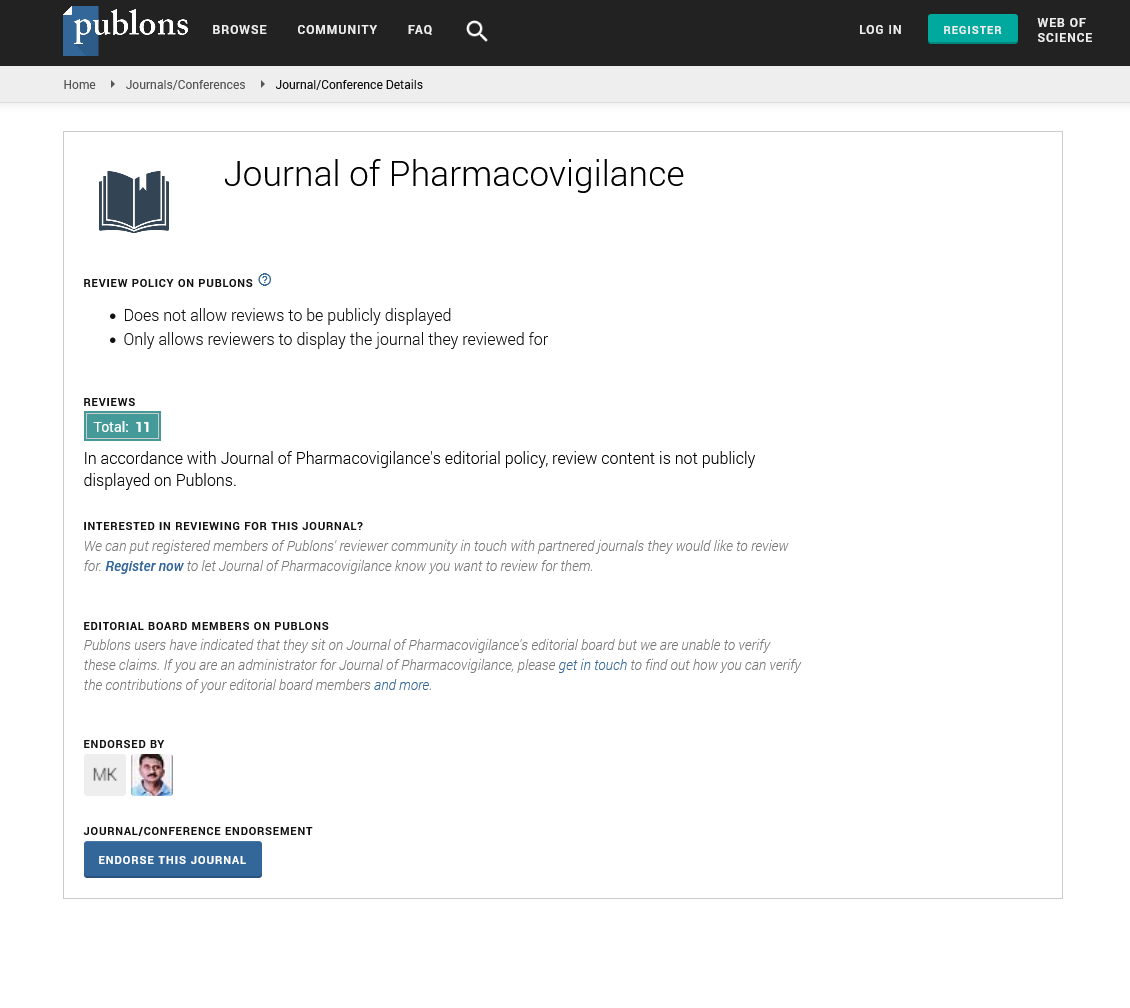Indexed In
- Open J Gate
- JournalTOCs
- The Global Impact Factor (GIF)
- RefSeek
- Hamdard University
- EBSCO A-Z
- OCLC- WorldCat
- Publons
- Euro Pub
- Google Scholar
Useful Links
Share This Page
Journal Flyer

Open Access Journals
- Agri and Aquaculture
- Biochemistry
- Bioinformatics & Systems Biology
- Business & Management
- Chemistry
- Clinical Sciences
- Engineering
- Food & Nutrition
- General Science
- Genetics & Molecular Biology
- Immunology & Microbiology
- Medical Sciences
- Neuroscience & Psychology
- Nursing & Health Care
- Pharmaceutical Sciences
Commentary Article - (2024) Volume 12, Issue 3
Enhancing Drug Safety through Proactive Pharmacovigilance Strategies and Innovations
Elara Finch*Received: 28-Aug-2024, Manuscript No. JP-24-27170; Editor assigned: 30-Aug-2024, Pre QC No. JP-24-27170(PQ); Reviewed: 13-Sep-2024, QC No. JP-24-27170; Revised: 20-Sep-2024, Manuscript No. JP-24-27170(R); Published: 27-Sep-2024, DOI: 10.35248/2329-6887.24.12.487
Description
Pharmacovigilance is a critical aspect of healthcare systems worldwide, ensuring that pharmaceutical products are safe for use by monitoring and evaluating their adverse effects. Traditionally, pharmacovigilance has been a reactive process, primarily relying on the collection and analysis of post-marketing adverse event reports. However, recent advancements in technology, data analytics and a shift in regulatory expectations have paved the way for more proactive risk management strategies, enhancing the effectiveness of pharmacovigilance. Historically, pharmacovigilance activities were largely driven by spontaneous reporting systems, where healthcare professionals and patients reported Adverse Drug Reactions (ADRs) to regulatory authorities and pharmaceutical companies. While this approach has been instrumental in identifying safety signals, it has limitations, including underreporting, data quality issues and delays in signal detection. Recognizing these challenges, the pharmaceutical industry and regulatory agencies have increasingly embraced proactive pharmacovigilance. This shift involves integrating pharmacovigilance activities throughout the drug development lifecycle, from preclinical studies to post-marketing surveillance. The goal is to identify, assess and mitigate risks early, ensuring that potential safety concerns are addressed before they pose significant threats to patients. Preclinical studies, including in vitro and in vivo experiments, play a crucial role in identifying potential toxicities and adverse effects of new drug candidates. Advanced technologies such as high-throughput screening, genomics and proteomics are used to predict safety issues early in the drug development process. By understanding a drug's safety profile at this stage, researchers can design safer compounds and reduce the likelihood of adverse effects in clinical trials. Regulatory authorities often require pharmaceutical companies to develop and implement Risk Management Plans (RMPs) for new drugs. RMPs outline strategies for identifying and mitigating risks associated with a drug's use. These plans may include specific safety studies, risk communication activities and post-marketing surveillance requirements. By proactively addressing potential risks, RMPs enhance patient safety and ensure regulatory compliance.
Traditional pharmacovigilance relies heavily on passive reporting systems, but active surveillance systems offer a more proactive approach. These systems actively collect and analyze data from various sources, including Electronic Health Records (EHRs), patient registries and insurance claims databases. By continuously monitoring drug safety in real-world settings, active surveillance systems can detect safety signals earlier and provide more comprehensive safety profiles for marketed drugs. Proactive pharmacovigilance involves continuous benefit-risk assessment throughout a drug's lifecycle. This approach considers not only the potential risks but also the therapeutic benefits of a drug. Benefit-risk assessments are dynamic and take into account new safety data, emerging risks and changing clinical practices. By regularly evaluating the balance between benefits and risks, pharmaceutical companies can make informed decisions about the continued use of their products. Implementing risk minimization measures is a key component of proactive pharmacovigilance. These measures aim to reduce the occurrence and severity of adverse events. Examples include restricted distribution programs for high-risk drugs, educational materials for healthcare providers and patients and dose adjustments based on patient characteristics. Effective risk minimization measures enhance patient safety and improve treatment outcomes.
Conclusion
Pharmacogenomics, the study of how genetic variations influence drug responses, is a good field for proactive pharmacovigilance. By identifying genetic markers associated with adverse drug reactions or therapeutic efficacy, researchers can develop personalized treatment strategies. These studies provide valuable real-world data on a drug's safety and effectiveness. Proactively conducting post-marketing safety studies allows pharmaceutical companies to monitor long-term safety, detect rare adverse events and gather evidence on the drug's performance in diverse patient populations. By integrating safety assessments throughout the drug development process, potential risks are identified and addressed early, reducing the likelihood of serious adverse events. Proactive risk management strategies enhance patient safety by minimizing the occurrence and impact of adverse drug reactions. This leads to better treatment outcomes and improved patient trust in pharmaceutical products.
Citation: Finch E (2024). Enhancing Drug Safety through Proactive Pharmacovigilance Strategies and Innovations. J Pharmacovigil. 12:487.
Copyright: © 2024 Finch E. This is an open-access article distributed under the terms of the Creative Commons Attribution License, which permits unrestricted use, distribution, and reproduction in any medium, provided the original author and source are credited.

